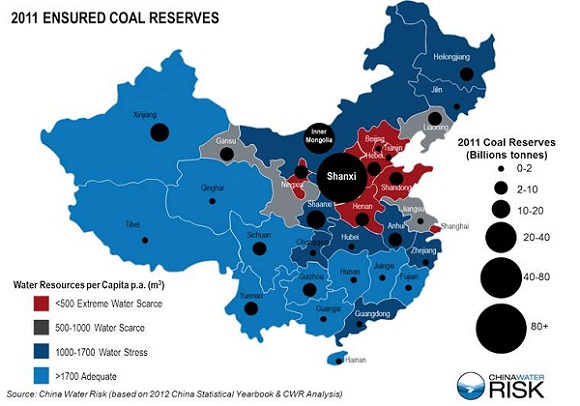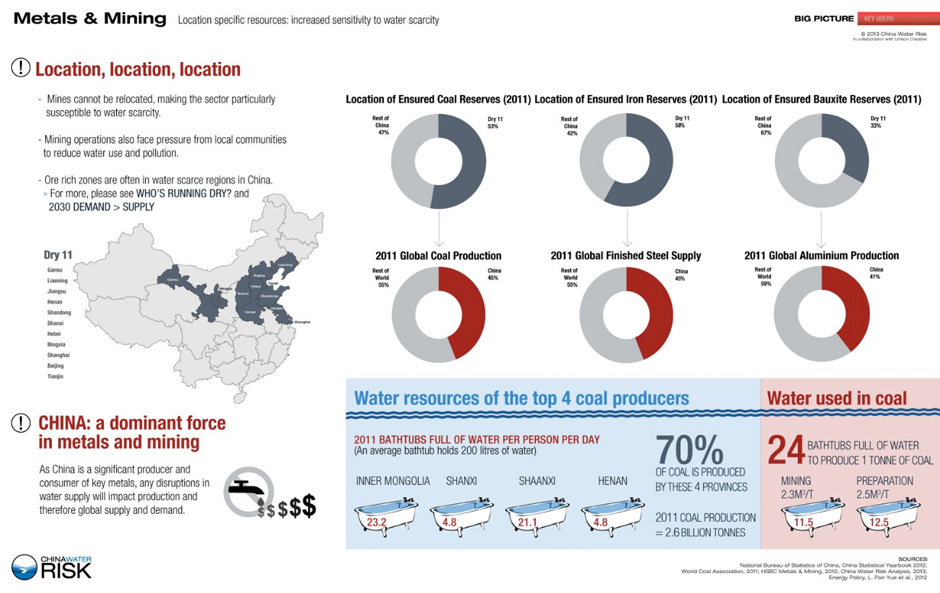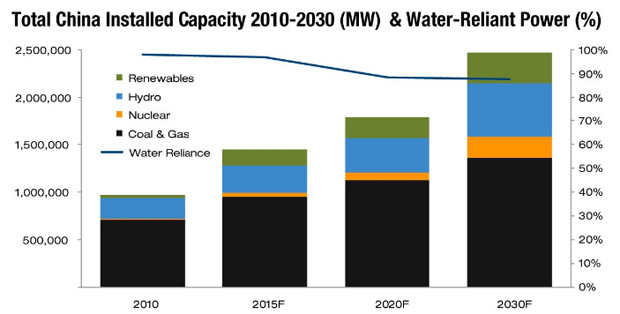When we think about water use we think about the water we drink, but we also need water to grow food, generate electricity, make our clothes, and extract minerals. In short, water drives the economy. In China, ninety-seven percent of electricity generated requires water to produce, so no water literally means no power.
Between 2010-2030, China plans to add 1.2 terawatts of water-reliant power. This is equivalent to adding more power than the combined installed power generation capacity of the United States, the United Kingdom, and Australia today. Coal is central to China’s energy policy.
Despite China’s efforts to curb its carbon emissions by cutting reliance on coal from around seventy percent of its energy mix to fifty-five percent, China’s coal-fired capacity is expected to increase by the equivalent of 450 gigawatts. This addition in coal-fired power is more than double the whole of India’s power generation today.
The role of coal in air pollution has received a lot of attention; lesser known is its impact on water. Not only is it water-intensive to mine, it is also polluting.
Around ninety-five percent of China’s coal is mined underground with heavy reliance on groundwater use. In Shanxi province, studies estimate that 1.07m3 of groundwater is destroyed per ton of coal extracted. With around seventy percent of coal production coming from Inner Mongolia, Shanxi, Shaanxi, and Hebei provinces, this may lead to further deterioration of the already polluted groundwater in the North China Plain.
Worse still is that fifty-three percent of China’s ensured coal reserves lie in water-scarce regions and thirty percent lie in water-stressed regions.
It takes twenty-four bathtubs full of water to extract and wash one ton of coal. China’s top coal producing provinces produced 2.6 billion tons of coal in 2011, but only have water resources equivalent to 4.8 to 23.2 bathtubs of water per person per day.
Given this, surely it is time to ask if China has enough water to fuel its power expansion plans.
The Ministry of Water Resources has recently moved to address this with the Water-for-Coal Plan released in December 2013 which states that future development of large coal bases in China will depend on the availability of regional water. Miners can invest in technology that not only treats waste water but allows them to extract more coal with less water.
Indeed, the 2011 water-in-mining spend in China is a mere U.S.$230 million compared with U.S.$1.5 billion in Australia and U.S.$794 billlion in Peru. With water-reliant power generation expected to remain high (falling from ninety-seven percent to eighty-seven percent by 2030), energy and water policies are expected to continue to dovetail.
Unfortunately, alternatives to coal such as gas, nuclear, and hydropower, although better for air, are also all constrained by water availability and each has its own set of serious implications. There are worries globally on the impact of water aquifers by hydraulic fracking for shale gas.
Recently, nineteen Chinese NGOs published a report saying that hydropower stations significantly damage China’s rivers. China’s 20,000 big dams are not only disrupting river flow causing transboundary river basins to fragment but could be changing ecosystems and endangering biodiversity. The planned build-out is significant: hydro capacity is expected to expand from 216 gigawatts in 2010 to 568 gigawatts by 2030.
This is an increase equivalent to Japan’s and Australia’s installed capacity as of 2009. With this size of hydropower expansion, China’s search for clean energy may bring about geopolitical tensions with neighboring countries as transboundary rivers such as the Upper Mekong, Salween, and Brahmaputra will be dammed.
The focus should not just be on “using less water” but on “saving energy,” as using less energy also saves water. The government’s push in the strategic emerging industry of “Environmental Protection and Energy Savings” is expected to do just that. If China does not employ “energy saving” strategies, China’s hunger for power will mean that China’s water resources will be even more stretched.






